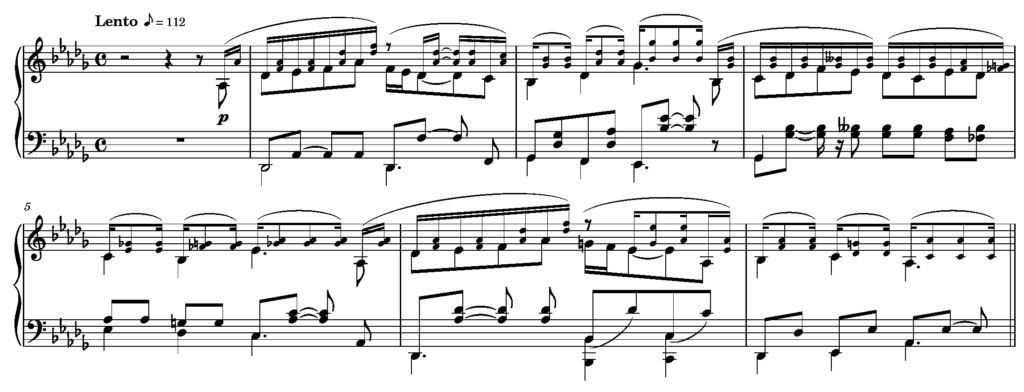Undoubtedly one of Chaminade’s most well-known and well-loved solo piano works, ‘Automne’ comes from the collection Études de Concert, op. 35. No fewer than four of the six etudes that comprise the set feature on diploma works lists. They are all gratefully written, and although they deserve the ‘etude’ title, their musical interest and audience appeal also fully justify the time invested in studying them. Chaminade herself seems to have held ‘Automne’ in particular esteem: Citron lists five public performances of this etude, including in London, Paris, and Philadelphia (which is more than her performances of the other five etudes from opus 36 combined).
As an etude, the primary technical focus in the A-section is on voicing and phrasing, while the B-section requires good rotation, chord-playing, and a good sense of keyboard geography. Particularly careful attention to the pedalling will also help, and there is an abundance of tempo-markings to make sense of. Although it’s not without challenges, ‘Automne’ is a very effective concert piece when played with technical assurance and musical authority. Let’s dive in!
Analytical commentary
The work is in ternary form, with an almost exact repeat of the A-section. The A-section itself is a ternary form, while the B-section approximates a rondo shape. The A-section’s atmosphere is redolent of Keats’s ‘mists and mellow fruitfulness’, with its lyrical melody and warm harmonic accompaniment, while the B-section is rather stormier.
| A | a | bb. 1-7 |
| b | bb. 8-17 | |
| a’ | bb. 18-29 | |
| B | a | bb. 30-37 |
| b | bb.38-49 | |
| a | bb. 50-59 | |
| c | bb. 60-71 | |
| a’ | bb. 72-77 | |
| A | a | bb. 78-84 |
| b | bb. 85-94 | |
| a’ | bb. 95-107 |
The construction of the A-section is somewhat typical of Chaminade’s structural approach. The six-bar opening paragraph consists of an antecedent-consequent phrase-pair, followed by the antecedent phrase again, altered to move to the dominant:

Melodically, the opening rise outlines an octave between the upper and lower dominant, and both subsequent phrases are contained within this compass. In contrast, the second phrase (beginning b. 8) breaks out of this constraint, pushing chromatically upwards to B♭, then sequentially to E♭. Harmonically, the music shifts to the minor mode of the dominant, A♭, which is established temporarily as the tonic by the end of bar 7. This in turn functions as the minor subdominant of our destination in the new phrase, E♭ minor, which arrives at bar 9. The process is then repeated taking us to A♭ minor at bar 11. Both phrases confirm the arrival of these keys by means of a ib–V7c–i progression, the bass falling stepwise through mediant and supertonic to the tonic. This second paragraph shares a rhythmic outline with the previous one, although the chromatic push upwards is now balanced by three repeated notes, rather than the ascending broken chord of the parallel phrase in the first paragraph.

Bars 12-15 comprise another sequential passage which takes us to a restatement of the opening subject in the bass, in B♭ major. This leads, via a diminished seventh, to a perfect cadence back into the home tonic at bar 18 for a repeat of the a-section, texturally expanded, and extended with a codetta (bars 24-29).
Although this A-section is an ostensibly ternary structure, it is worth observing that the melodic relationship between the a- and b-sections obscures these structural divisions and, along with the irregular phrase-lengths, creates instead a feeling of ongoing development. The ternary structure is felt most strongly in the texture. The a-section is homophonic, even if the melody avoids the soprano until the restatement in bars 18-23; see also how the codetta returns to the texture and tessitura of the opening. The b-section is more imitative, with the soprano and bass often engaging in contrary motion, and the accompanying chords lying in between; even in bars 16-17, where the bass melody appears to dominate, the soprano soon pushes us away from the B♭-major territory with an ascending chromatic conjunct minor third, F to A♭, thereby steering us back to A♭ major.
(There is a wonderful textural touch at bars 20-21, by the way, where the tenor joins the soprano to double the melody an octave lower.)


Pingback: Featured composer: Cécile Chaminade (1857-1944)